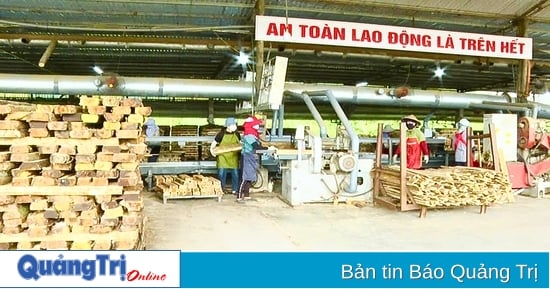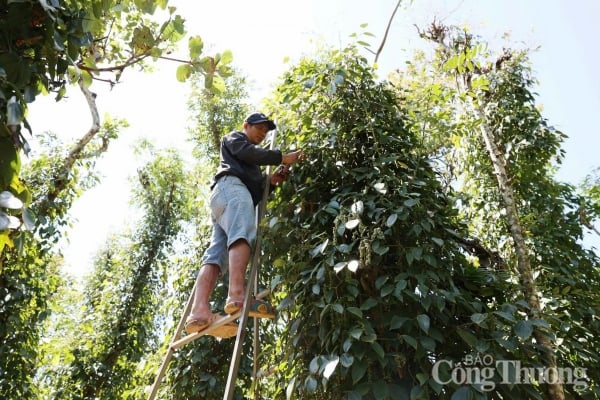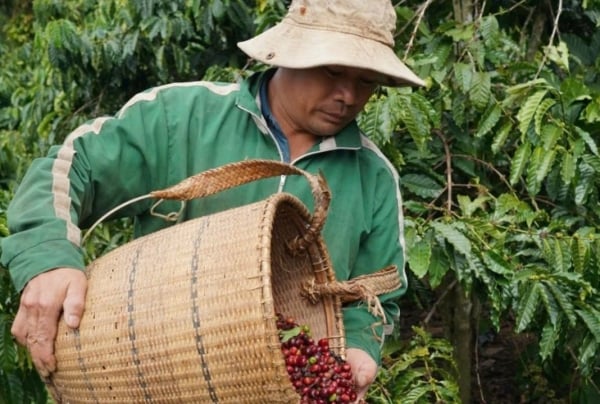Wood industry enterprises must comply with the European Union (EU) Deforestation Prevention Regulation (EUDR) when exporting to this market. However, until now, enterprises still do not have specific instructions, so they are both producing and worrying.
Working and waiting
According to the Binh Dinh Timber and Forest Products Association, in 2023, Binh Dinh exported nearly 1 billion USD worth of wood products to more than 100 countries; in the first half of 2024, the export turnover reached 575 million USD, an increase of 30% over the same period in 2023. The wood processing industry accounts for about 60 - 65% of the province's total export turnover.
The province currently has nearly 10,000 hectares of large timber forests. The forest area granted the Forest Stewardship Council (FSC) certificate is nearly 15,000 hectares; of which, the large timber forest area is more than 7,600 hectares.
It is expected that by 2025, the total area of concentrated large timber plantations in the province will reach 10,000 hectares, the area of FSC-certified plantations will be nearly 16,000 hectares; by 2030, the area of concentrated large timber plantations will reach over 50,000 hectares, the average large timber output rate will reach over 60%.
Along with the orientation of planting large timber forests, Binh Dinh is currently one of the four largest wood processing centers in Vietnam and is known as the "wood industry capital" of the country; is one of the centers for developing industry clusters for wood processing and forestry products.
Normally, the fourth quarter of each year is the time when Binh Dinh wood industry enterprises “race” to promote and seek to sign orders for the following year. However, this year, enterprises are “sitting on fire” because the EU’s anti-deforestation regulations will take effect in December 2024. Meanwhile, Vietnam’s regulations on determining the origin of wood are not yet specific.
Mr. Tran Van Phuc, Director of the Department of Agriculture and Rural Development of Binh Dinh, informed that EUDR sets out two core requirements for wood and wood products circulating in this market: not to deforest and to ensure the legality of the supply source.
To meet the EUDR requirements, wood product suppliers must provide information on the geographical location of the growing areas and demonstrate that production at these locations has not resulted in deforestation since 31 December 2020.
The Department of Agriculture and Rural Development assessed that, in general, most of the production forest areas in the province were planted before 2020 and have a low risk of being classified as a risk group causing deforestation and forest degradation. However, in reality, to prove this, there are many challenges due to the lack of necessary legal evidence.
“When the EUDR regulation comes into effect, it will have a significant impact on the wood industry of the province as well as the whole country,” Mr. Phuc acknowledged.
Wood industry enterprises are very confused by this regulation, so they are working and "waiting". As a business specializing in manufacturing interior and exterior wooden furniture, exporting products to major markets around the world such as the EU, America, Asia, Australia, New Zealand... even though they have orders until the second quarter of 2025, Hoang Hung Company Limited is still very worried about the EUDR regulation.
When asked what solutions the company has to meet the requirements from European partners related to the EUDR regulation, the company representative appeared passive, saying that they are waiting for the EU Parliament to decide on extending the time to apply this regulation.
Risk of not being able to export goods to the EU
Mr. Le Minh Thien, Chairman of the Binh Dinh Timber and Forest Products Association, is worried that by December 31, if businesses do not provide complete documents as required by EUDR, the risk of not being able to export goods to the EU is real.
"Currently, businesses are focusing on orders until December 31, but after that they do not dare to do it even though they have orders," Mr. Thien stated the reality.
It is known that Binh Dinh currently has more than 350 wood processing enterprises and facilities concentrated in Quy Nhon City, Hoai Nhon Town and Tuy Phuoc and Phu Cat Districts. Of which, over 50% of wood industry enterprises export to the European market.
Wood processing and exporting enterprises in the province have a clear understanding of the EU's anti-deforestation regulations. They also proactively require organizations, individuals or intermediary enterprises supplying raw materials to ensure legality and provide the geographical location of the growing area, but the suppliers themselves are still confused.
From the perspective of a state management agency, to remove difficulties for businesses, the Department of Agriculture and Rural Development of Binh Dinh has advised the Provincial People's Committee to issue a Plan to implement solutions to adapt to the EU's non-deforestation regulations in Binh Dinh province.
“In the coming time, the Department of Agriculture and Rural Development will coordinate with departments, branches and localities to take measures to remove legal obstacles for forest land areas that have not been granted red books, or have red books but do not have geographical location indications. At the same time, the Forest Protection Department will coordinate with relevant parties to propose solutions to build a database and digital maps on the current status of forests, ensuring adequate information to control, trace the origin and geographical indications of wood and wood products,” said Mr. Tran Van Phuc.
Source: https://baodautu.vn/nganh-go-binh-dinh-thap-thom-voi-quy-dinh-moi-cua-eu-d227359.html









































Comment (0)